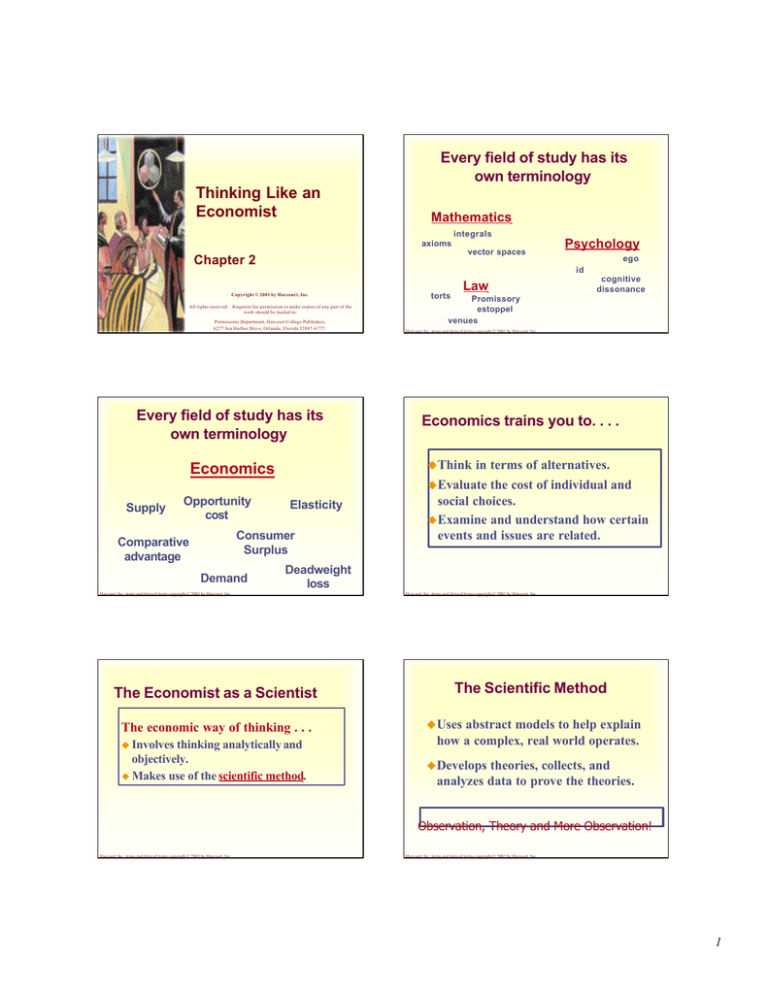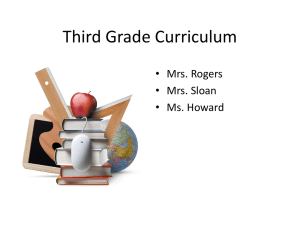
Every field of study has its
own terminology
Thinking Like an
Economist
Mathematics
integrals
axioms
vector spaces
Chapter 2
All rights reserved. Requests for permission to make copies of any part of the
work should be mailed to:
Permissions Department, Harcourt College Publishers,
6277 Sea Harbor Drive, Orlando, Florida 32887-6777.
Every field of study has its
own terminology
Elasticity
Consumer
Surplus
Comparative
advantage
Demand
cognitive
dissonance
Promissory
estoppel
venues
Harcourt, Inc. items and derived items copyright © 2001 by Harcourt, Inc.
Economics trains you to. . . .
in terms of alternatives.
uEvaluate the cost of individual and
social choices.
uExamine and understand how certain
events and issues are related.
Deadweight
loss
Harcourt, Inc. items and derived items copyright © 2001 by Harcourt, Inc.
The Economist as a Scientist
The economic way of thinking . . .
u Involves
Law
torts
uThink
Economics
Opportunity
cost
ego
id
Copyright © 2001 by Harcourt, Inc.
Supply
Psychology
thinking analytically and
objectively.
u Makes use of the scientific method.
Harcourt, Inc. items and derived items copyright © 2001 by Harcourt, Inc.
The Scientific Method
uUses
abstract models to help explain
how a complex, real world operates.
uDevelops
theories, collects, and
analyzes data to prove the theories.
Observation, Theory and More Observation!
Harcourt, Inc. items and derived items copyright © 2001 by Harcourt, Inc.
Harcourt, Inc. items and derived items copyright © 2001 by Harcourt, Inc.
1
The Role of Assumptions
Economists make assumptions in order
to make the world easier to understand.
u The art in scientific thinking is deciding
which assumptions to make.
u Economists use different assumptions to
answer different questions.
u
Economic Models
Economists use models to simplify reality
in order to improve our understanding of the
world
u Two of the most basic economic models
include:
u
u
u
Harcourt, Inc. items and derived items copyright © 2001 by Harcourt, Inc.
The Circular Flow Model
The Production Possibilities Frontier
Harcourt, Inc. items and derived items copyright © 2001 by Harcourt, Inc.
The Circular-Flow Diagram
The Circular-Flow Model
The circular-flow model is a
simple way to visually show the
economic transactions that occur
between households and firms in
the economy.
Revenue
Goods &
Services sold
Firms
The Circular-Flow Diagram
Firms
u Produce
u Hire
and sell goods and services
and use factors of production
Households
u Buy
and consume goods and services
u Own
and sell factors of production
Harcourt, Inc. items and derived items copyright © 2001 by Harcourt, Inc.
Spending
Goods &
Services
bought
Households
Inputs for
production
Wages, rent,
and profit
Harcourt, Inc. items and derived items copyright © 2001 by Harcourt, Inc.
Market for
Goods
and Services
Market for
Factors
of Production
Labor, land,
and capital
Income
Harcourt, Inc. items and derived items copyright © 2001 by Harcourt, Inc.
The Circular-Flow Diagram
Markets for Goods & Services
u Firms sell
u Households
buy
Markets for Factors of Production
u Households
u Firms
sell
buy
Harcourt, Inc. items and derived items copyright © 2001 by Harcourt, Inc.
2
The Circular-Flow Diagram
The Production Possibilities
Frontier
Factors of Production
u Inputs used to produce goods and
services
u Land,
labor, and capital
u Capital –
equipment and structures use
to produce goods and services (eg.
machines).
Harcourt, Inc. items and derived items copyright © 2001 by Harcourt, Inc.
Harcourt, Inc. items and derived items copyright © 2001 by Harcourt, Inc.
The Production Possibilities
Frontier
Quantity of
Computers
Produced
D
B
300
1,000
600 700
1,000
Quantity of
Cars Produced
Concepts Illustrated by the
Production Possibilities Frontier
uEfficiency
C
2,200
2,000
A
Harcourt, Inc. items and derived items copyright © 2001 by Harcourt, Inc.
D
3,000
C
2,200
2,000
0
The Production Possibilities
Frontier
Quantity of
Computers
Produced
3,000
1,000
The production possibilities frontier is a
graph showing the various combinations
of output that the economy can possibly
produce given the available factors of
production and technology.
0
A
Production
possibilities
frontier
B
300
600 700
1,000
Harcourt, Inc. items and derived items copyright © 2001 by Harcourt, Inc.
Quantity
of Computers
Produced
4,000
The Production
Possibilities Frontier
An outward shift
in the production
possibilities
frontier
3,000
uTradeoffs
uOpportunity
Cost
uEconomic Growth
2,100
2,000
0
Harcourt, Inc. items and derived items copyright © 2001 by Harcourt, Inc.
Quantity of
Cars Produced
E
A
700 750
Harcourt, Inc. items and derived items copyright © 2001 by Harcourt, Inc.
1,000
Quantity of
Cars Produced
3
PPF Exercise - Continued
PPF Exercise – Athletic Country
Bats
Rackets
1.
Is producing 200 bats and 400 rackets feasible?
0
420
2.
Is producing 200 bats and 200 rackets efficient?
100
200
400
360
3.
300
400
300
200
Suppose AC is producing 200 bats and 200 rackets. How many
additional bats could they produce without giving up any
rackets?
4.
If Athletic Country currently produces 100 bats and 400 rackets,
what is the opportunity cost of an additional 100 bats?
5.
If AC currently produces 300 bats and 300 rackets, what is the
opportunity cost of an additional 100 bats?
6.
Why is the opportunity cost higher in part 2 than in part 1?
500
0
Plot the production possibility frontier for Athletic
Country.
Place Bats on the x-axis and Racket on the y-axis.
Harcourt, Inc. items and derived items copyright © 2001 by Harcourt, Inc.
Harcourt, Inc. items and derived items copyright © 2001 by Harcourt, Inc.
PPF Exercise – Continued
u Microeconomics
focuses on the individual
parts of the economy.
Production Possibilities Frontier
450
400
u How
households and firms make decisions
and how they interact in specific markets
350
Rockets
Microeconomics and
Macroeconomics
300
250
200
u Macroeconomics
150
100
looks at the economy as
a whole.
50
0
0
100
200
300
400
500
Bats
Harcourt, Inc. items and derived items copyright © 2001 by Harcourt, Inc.
Two Roles of Economists
uWhen
they are trying to explain the
world, they are scientists.
uWhen they are trying to change the
world, they are policymakers.
u How
the markets, as a whole, interact at the
national level.
Harcourt, Inc. items and derived items copyright © 2001 by Harcourt, Inc.
Positive versus Normative
Analysis
uPositive
statements are statements
that describe the world as it is.
uCalled
descriptive analysis
uNormative
statements are
statements about how the world
should be.
uCalled prescriptive
Harcourt, Inc. items and derived items copyright © 2001 by Harcourt, Inc.
analysis
Harcourt, Inc. items and derived items copyright © 2001 by Harcourt, Inc.
4
Positive or Normative
Statements?
Positive Versus Normative
n
?
?
A key difference between positive and
normative statements is how we judge
them.
State governments should be allowed to
collect from tobacco companies the
costs of treating smoking -related
illnesses among the poor.
äWe can confirm or refute positive statements
by examining evidence.
äEvaluating normative statements involves
values as well as facts.
?
Harcourt, Inc. items and derived items copyright © 2001 by Harcourt, Inc.
Harcourt, Inc. items and derived items copyright © 2001 by Harcourt, Inc.
Positive or Normative
Statements?
Positive or Normative
Statements?
?
?
An increase in the minimum wage
will cause a decrease in employment
among the least-skilled.
?
Higher federal budget deficits will
cause interest rates to increase.
?
Harcourt, Inc. items and derived items copyright © 2001 by Harcourt, Inc.
Harcourt, Inc. items and derived items copyright © 2001 by Harcourt, Inc.
Positive or Normative
Statements?
?
?
?
Positive or Normative
Statements
?
The income gains from a higher
minimum wage are worth more than
any slight reductions in employment.
Harcourt, Inc. items and derived items copyright © 2001 by Harcourt, Inc.
?
n
The sky is green.
n
Positive statements attempt to describe
the world as it is. It is possible that a
positive statement can be proved false.
Harcourt, Inc. items and derived items copyright © 2001 by Harcourt, Inc.
5
Economists in Washington . . .
. . . serve as advisers in the
policymaking process of the three
branches of government:
Legislative
u Executive
u Judicial
u
Harcourt, Inc. items and derived items copyright © 2001 by Harcourt, Inc.
Why Economists Disagree
uThey
may disagree on theories
about how the world works.
uThey
may hold different values
and, thus, different normative
views.
Harcourt, Inc. items and derived items copyright © 2001 by Harcourt, Inc.
Examples of What Most
Economists Agree On
uA
ceiling on rents reduces the
quantity and quality of housing
available.
uTariffs
and import quotas usually
reduce general economic welfare.
Harcourt, Inc. items and derived items copyright © 2001 by Harcourt, Inc.
Summary
uIn
order to address subjects with
objectivity, economics makes use of the
scientific method.
uThe
field of economics is divided into
two subfields: microeconomics and
macroeconomics.
Harcourt, Inc. items and derived items copyright © 2001 by Harcourt, Inc.
Summary
uEconomics
relies on both positive
and normative analysis. Positive
statements assert how the world “is”
while normative statements assert
how the world “should be.”
uEconomists may offer conflicting
advice due to differences in scientific
judgments or to differences in
values.
Harcourt, Inc. items and derived items copyright © 2001 by Harcourt, Inc.
6








